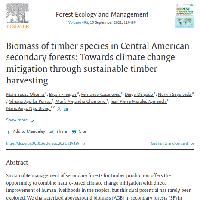Resumen
- Sustainable management of secondary forests for timber production offers the opportunity to combine nature-based climate change mitigation with direct improvement of human livelihoods in the tropics, but this dual potential has rarely been explored. We characterized aboveground biomass (AGB) in secondary forests (SF) in Nicaragua and Costa Rica in whole stands (ecological potential), individual trees of timber species (total timber potential), and currently harvestable timber (harvestable timber potential). We also linked the three types of AGB potential to climate and soil factors. Data on 302 sample plots were collected, most from national forest inventories (NFIs) concerning 168 plots in Nicaragua and 134 plots in Costa Rica. We analyzed data from individuals ≥20 cm dbh, estimating biomass from field measurements of stem diameters, and wood density and tree height estimates from the BIOMASS package in R. We obtained climate data from CHELSA, soil data from the ISRIC world soils database and determined the relationship between the three AGB potentials and environmental variables using exploratory principal components analysis and general linear mixed models (GLMMs). A mean 51 Mg ha⁻¹ AGB was found to be stored in trees ≥20 cm dbh in dry forests and 68 Mg ha⁻¹ in wet forests. Maximum values were > 250 Mg ha⁻¹ in both biomes, similar to primary forest values from the NFIs. Timber potential was high at 84% of the mean ecological potential of the study plots, with 73% in the currently harvestable category. Overall, both ecological and total timber potential AGB were significantly higher in wet than in dry forests, whereas currently harvestable timber potential was significantly higher in dry than in wet forests. The best GLMMs showed R² = 0.31, 0.24 and 0.27 for ecological, total timber and harvestable timber potentials, respectively (P < 0.0001). All three models included soil clay and silt fractions, soil C/N ratio, mean annual precipitation and temperature seasonality. The GLMM for ecological potential included soil pH and climatic water deficit, while those for the two timber potentials included mean annual temperature. Overall, GLMMs indicate increasing timber AGB potential with increasing rainfall, decreasing climatic seasonality, and soil fertility. All three AGB potentials were significantly higher in Costa Rica than in Nicaragua in both biomes. This observed non-environmental “country effect” requires further study
